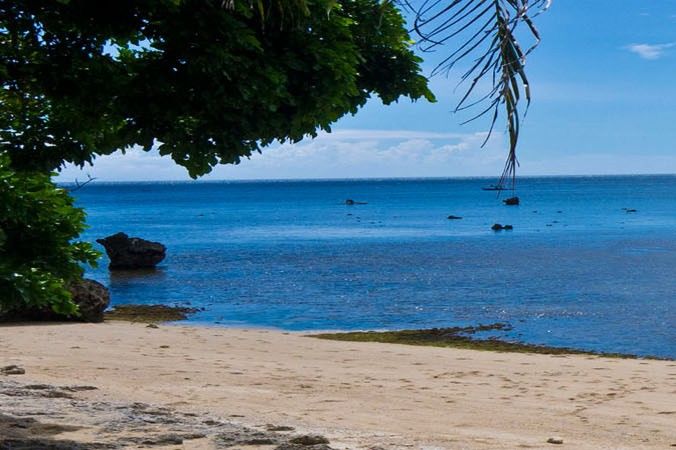A Siaton guidebook to the lost gaze


Our visit to Negros, the first in almost three years, was inauspicious because of the occasion of brother-in-law’s death in Siaton, one of the towns on the island’s southern tip. Around an hour’s drive from the capital Dumaguete City, Siaton is one of the oriental province’s best kept secrets, an idyllic place where birdsong can be heard clearly on mornings and the sound of cicadas descend with nightfall.
It was in the town’s river where first we swam almost 40 years ago, along with the occasional horse being given a bath by its owner in the shallower parts, and the laundrywomen in the stony side making a racket with their paddles. Underneath the sloping hill on the opposite side the legendary Don Antoy was said to reside, as silent as his magic and water moths and later segueing into a name of a modest jeepney line transporting passengers from Siaton to Dumaguete and back, more or less an hour’s drive that passed through the winding road of Bondo and the scenic Kilometer 44.
Pacquiao fights were special then, held usually on a Sunday morning local time, where first the drivers and conductors and later the boat crew of Don Antoy would gather over beer, brandy and balbacua, an ox feet stew of thick soup that was comfort food and staved off drunkenness, which was a dish whipped up by the bayaw Isagani on such occasions, the troop whooping it up whenever the Pacman scored a knockout or at least a knockdown, or even without one the unanimous decision was that the balbacua kept us on our feet despite all the alcohol that sometimes included the native tuba.
Underneath the in-laws’ house once there were ducks’ eggs laid by the roving posse of pato and itik, which I personally harvested squatting on my haunches and moving around underneath like a duck itself, an impromptu Easter egg hunt to retrieve the large eggs with their large yokes.
On the side of the house in the adjacent lot stood some scrawny guyabano trees that lined the makeshift fence, you could pick out a few at a good height with a sungkit or stick with a small knife attached to its end, if not a round-shaped wire sometimes bearing a net. Or else the fruit would fall freely, as did the small mangoes or supsupin outside the kitchen, the fermenting sweetness filling the air or soaking the ground toward summer’s end.
Outside the dirty kitchen there used to be a lone cashew tree with its distinctively tart, juicy fruit, though it was prized for its nut at the crown of the fruit that was made into a delicacy, though there was never enough fruits to make nuts out of on our side of town. One can go on and on about the fruits and then some in the in-laws’ house, the endless santol harvested from the roof shortly before catching the boat back to Manila, the caimito by the hammock for merienda and its surplus made into ice cream, the Cambodian (or is it giant Indian mangoes?) which we brought back to the city in boxes.
If there was good catch overnight in the high seas the Don Antoy crew would drop off some fresh fish or squid by the gate, to be made into kinilaw, tangy with the bark of siniguelas, or roasted or made into soup or adobo, choose your wild.
There used to be chickens too, and a three-legged cat, about which I stupidly asked the father-in-law if veterinarians were of any use but he said we just let them be, they live or die. It was the youngest brother who nonchalantly slit the throat of a chicken for dinner tinola, away from clumsy city hands that would have led to a bloody squawking spectacle worse than pinikpikan, except maybe such scenarios occurred only in dreams.
A 15- to 20-minute walk away through country road was the beach in Mantuyop, alternately called Ragmont or Montesol depending on whose conjugal property it was located, nondescript if not low-profile yet providing what was most needed for the vacationing urban dweller, vitamin sea, that offered a good view of the sun slowly setting among coconut trees, and the sky turning into a riot of colors; it was best to get out of the water by then, start the dripping trek home before the fireflies come out by a pair of roadside baletes that doubtless have stories of their own.
And what stories were that? That a young man would find refuge in a town south of Negros, and discover that the taste of fresh fish went well with rum. That the man would grow into senior citizenship and dream of writing the intermittent column despite spotty Wi-Fi, about the burying of a brother-in-law and the last balbacua, and kids selling candles in sari-sari stores leading to the hilltop cemetery, the walk covering approximately the same distance to the beach, but in the opposite direction.
In the old house there’s always the fear of ancestors moving in, as if they ever left, but for the vigilance of the nth dog as faithful guard, Tsoko who descended from Ranger, and before them Sendong and Abdul, while in the living room missing a mask of Willie Arseña and print by Ching Abad Santos called Kamatayan, records of Benny Goodman wait to be played.















